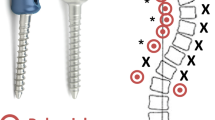Abstract
Burst fractures typically occur at T12 or L1 and create a sagittal deformity by a compression mechanism. This posttraumatic kyphosis is evaluated preoperatively by measuring the sagittal index of Farcy. Posterior instrumentation using in situ contouring is based on a bilateral insertion of rods which take the shape of the spine first. The rods are placed in a perpendicular position to monoaxial pedicular screws and then bent in situ, which makes the spine follow the movements of the rods. This principle makes it possible to correct the posttraumatic kyphosis at the level of the fractured vertebra and the overlying disk, which will open progressively using a ligamentotaxis mechanism. An additional anterior approach is indicated if the sagittal correction through the disk represents less than 50% compared to the total correction (in otherwords, if the correction of the traumatic deformity is obtained more in the disk than in the bone (>50%), an additional anterior approach is performed: more through the disk than the vertebral body (>50%)). This reliable technique meets the requirements of sagittal posttraumatic kyphosis correction, and provides a solid construct which avoids bracing.




Similar content being viewed by others
References
Farcy JP, Weindenbaum M, Glassman SD (1990) Sagittal index in management of thoracolumbar fractures. Spine 9:958–965
Roy-Camille R (1986) Internal fixation of thoracolumbar spine with pedicle screw plating. Clin Orthop Relat Res 203:7–17
Steib JP, Aoui M, Mitulescu A, Bogorin J, Chiffolot X, Cognet JM, Simon P (2006) Thoracolumbar fractures surgically treated by “in situ contouring”. Eur Spine J 15:1823–1832
Wood KB, Bohn D, Mehbod A (2005) Anterior versus posterior treatment of stable thoracolumbar burst fractures without neurological deficit. J Spinal Disord Tech 18(Suppl):15–23
Yerbi SA, Ehteshamui JR, Mc Laine RF (1997) Offset laminar hooks decrease bending moments of pedicle screws during in situ contouring. Spine 22:376–381
Conflict of interest statement
None of the authors has any potential conflict of interest.
Author information
Authors and Affiliations
Corresponding author
Additional information
An erratum to this article can be found at http://dx.doi.org/10.1007/s00586-009-1174-7
Rights and permissions
About this article
Cite this article
Steib, JP., Charles, Y.P. & Aoui, M. In situ contouring technique in the treatment of thoracolumbar fractures. Eur Spine J 19 (Suppl 1), 66–68 (2010). https://doi.org/10.1007/s00586-009-1119-1
Received:
Published:
Issue Date:
DOI: https://doi.org/10.1007/s00586-009-1119-1




